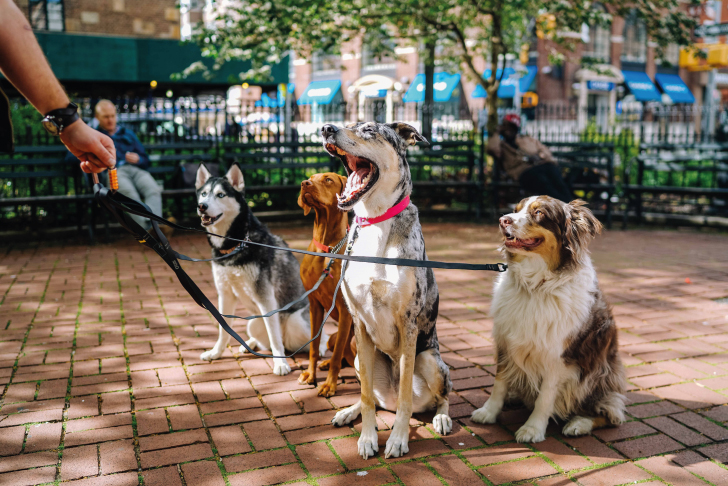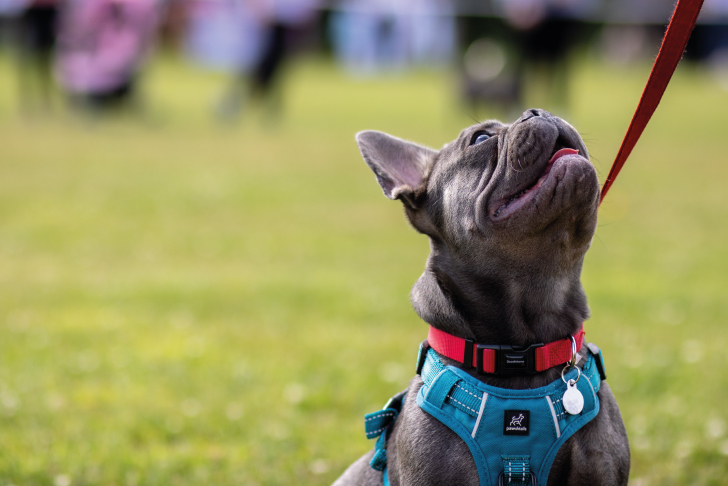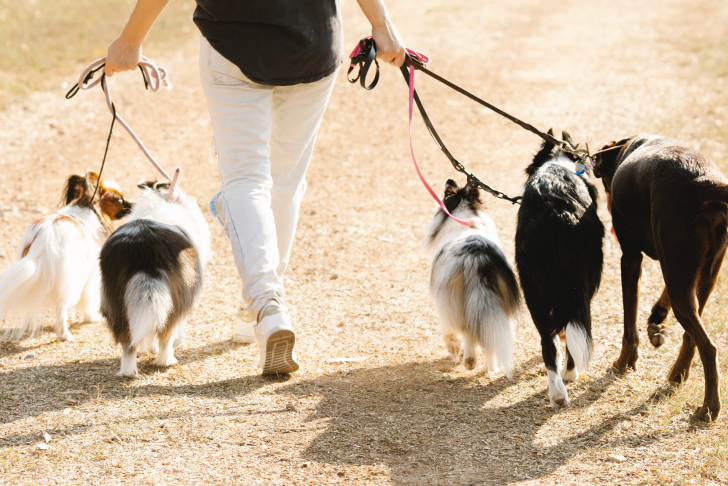Out of the 69% of Australian households with pets, almost half of them own dogs! So, it’s safe to say there are plenty of furry friends who need their exercise.
But surely everyone walks their own dogs, right?
While some do, there are many dual-income families who don’t have the time due to work and family commitments. So, they need a trusty dog walker on speed dial to ensure their pooch is happy and healthy.
But there is a lot of competition in the dog walking industry due to its low entry barriers. To combat this, you need to understand the industry and how to position yourself for success.
This guide will cover the important elements, such as marketing and registering your business, and ultimately teach you how to start a dog walking business in Australia.
Is starting a dog walking business profitable?

Dog walking businesses can certainly be profitable.
A prominent dog walker business states on its website that, on average, its franchisees earn $19,417 or $233,000 per year. However, some successful dog walking companies earn up to $40,000 annually.
But how much do dog walkers charge per hour? Dog walkers in Brisbane typically charge between $31 - $50 per hour, per dog. However, most people walk multiple dogs at the same time, significantly increasing this hourly rate.
You can also search for pet walking jobs to figure out how much dog walkers get paid in Australia. But remember you should be charging more than this since you’ll be paying for the business’s expenses!
If you’re concerned about the economic environment affecting dog walking demand, don’t be.
People who pay for dog walking typically aren’t average spenders, they’re busy dual-income households. On top of this, some Australian states even have the right to issue hefty fines to owners who don’t walk their pets. So, the service is a necessity, rather than a luxury.
Find out more: Need funding? Check out our guide on small business grants.
Why should you start a dog walking business?
Starting a dog walking business may seem like a dream come true for many people, but you need to have the right personality for the industry.
Outside of the typical attributes that all business owners need, dog walkers tend to be energetic, fit people with the ability to easily understand a dog’s body language. They also require a high degree of spatial awareness while walking with dogs to keep them safe.

If you fit the profile, the business comes with some excellent benefits:
- Interacting with and caring for cute, furry animals all day long.
- Getting daily exercise to keep you healthy.
- Strong demand for dog walking services.
However, there are also some risks that you should consider:
- Certain dogs may start a fight, causing injuries.
- The low barrier to entry can make it difficult to stand out.
- Demand for dog walking could be too low in your area.
While this isn’t an exhaustive list, it gives you a better idea of whether you should start a dog walking business.
What are the start-up costs for starting a dog walking business?

Before you start a dog walking business, you should budget at least $40,000 if you need a vehicle and certifications. However, you could start with as little as $4,000 if you forgo them.
Here are some costs to plan for:
- Certifications: $1,615 - $7,260 (this number can drop to $0 if you qualify for government funding).
- Police check: $50 - $200.
- Van: $30,000 - $80,000 (you may be able to use a smaller vehicle depending on the number of dogs you pick up at any one time).
- Insurance: $600 (recurring cost).
- Dog walking equipment: $500 - $2,000.
- Website: $50 - $300+ (recurring cost)
While most costs are manageable if you need to buy a vehicle, consider applying for a business grant. You can learn more about them in our small business grants guide.
But if you don’t qualify for one, another option is to take out a business loan. If you’ve never done this before, check out our small business loan guide for more information.
How to start your dog walking business
If you’ve made it this far, chances are you’re set on starting your dog walking business. This section will discuss the initial steps you need to take.
Research your market
Dog walking demand not only differs between cities but also in certain suburbs.
Do some research to figure out which areas are family-oriented and also relatively wealthy (upper-middle class) as these are the customers that will likely pay for your services. However, elderly owners may also need your services if they’re unable to walk their dogs.
Along with this, figure out more about these dog owners, such as:
- How often they walk their dogs.
- Whether they think their dogs are getting enough exercise.
- Any issues that prevent them from walking their pooches.
You can survey your target market by knocking on doors or leaving flyers in their mailboxes, but ensure you provide an incentive for participating, such as a discounted or free walk.
What are the regulations you need to know to start a dog walking business?
Dog walking isn’t a highly regulated industry, but there are some you must follow.
You must ensure that:
- You clean up and dispose of dog droppings or face a potential fine of up to $250 in certain cities.
- The dogs you walk wear an identification tag and are always leashed unless in a designated area.
- Dogs are well-behaved while walking and don’t show aggression to others.
- If walking through farmland, the dogs mustn’t disturb the livestock, or you could face serious fines.
Do you need a license or training to start a dog walking business?
There aren’t any official licenses or training needed to start a dog walking business. But one caveat is that your local council may require a license if you walk several dogs at once so it’s best to enquire with them.
However, if you want to be extra prepared, there are courses you can take, such as a Cert II or Cert III in Animal Care Services. These programs cost between $1,615 - $7,260 depending on your eligibility and will teach you many skills beyond how to be a dog walker, such as behavioural science and animal first aid.
While not a necessity, they can help you stand out from other professional dog walkers and broaden the services you offer.

Setting up your dog walking business
Now, let’s go through the detailed steps of how to set up your new dog walking business:
- Register your business.
- Learn how to file taxes.
- Decide on your pricing model.
- Choose your mode of transport.
- Create your contracts.
- Register a domain name.
- Invest in dog walking gear.
Let’s break them down.
1. Register your business
To formally set up your dog walking business, head to the Australian Government’s Business Registration Service.
Here, you’ll choose your business structure and apply for an ABN and ACN (depending on the structure you choose. In case you’re brand new to business:
- ABN = Australian Business Number.
- ACN = Australian Company Number.
The most common business structure is the sole trader where you are the sole owner and likely the only worker as well. While you can employ people within this structure, it’s not common as you’re liable for all your business’s debts and obligations.
Other structures include:
- Partnerships.
- Limited Liability Companies (LLCs).
- Corporations.
You can learn more about these business structures through the Australian Government’s Business Structures page.
2. Learn how to file taxes
When filing taxes you have two options. You can either do it yourself through the Australian Tax Office’s myTax portal or you can use any local tax accountant.
Whichever option you choose, be sure to log all your business income and expenses as well as keep receipts and invoices as proof. Your tax return should also be filed from July 1st until no later than October 31st.
Unless you’re well-versed in taxation laws, we’d recommend using an agent so that everything is correct.
3. Decide on your pricing models
It’s important to have different pricing models and dog walker rates so that customers find something that fits them.
You can offer more expensive one-off payments for customers that need your services on the fly or discounted subscriptions for regular walks to bring predictability to your income. Alternatively, you can offer bulk upfront payments for owners who need lots of walks but have an unpredictable schedule.
4. Choose your mode of transport
If you’re only walking dogs around your local area, you can get away with using a bicycle or walking. But if you’re expected to take dogs on outings, such as to the dog park, you will need a car.
The most practical option is to get a van as this allows you to transport multiple dogs, but you can also use a sedan if you have a small budget.
5. Create your contracts
Before you take on clients, you must have a contract that stipulates all the terms and conditions of your services.
You can use an online template, such as this dog walking contract template but we’d recommend using one written by a lawyer so that all your bases are covered.

6. Register a domain name
Online searches are a common way for customers to find your business. That means you need a website and a domain name.
Your domain will typically be the same as your business name, for example, I Walk Dogs would become iwalkdogs.com.au. You can head to GoDaddy and use their domain search tool on the front page to figure out if yours is available.
7. Invest in dog walking gear
Dog walking gear comes in a range of prices depending on whether you use basic options or prefer stylish, designer gear.
You can find basic gear at Bunnings or your local pet store. Alternatively, you can find designer gear at boutique stores, such as Wolf and I Co.
Ensure you have multiples of each size as you never know what combination of dogs you will walk at any one time.
How to grow your dog walking business
Growing your dog walking business is all about creating a cohesive brand, building a reputation, and getting your name in front of customers.
Firstly, you may want to choose a niche for your business so that you better appeal to your target customer. For example, focusing on large or aggressive breeds as these typically require different skills.
Based on this, you’ll be able to design a logo that appeals to your customers. Think tough and rugged if you plan to walk large dogs or cute and dainty if you focus on small breeds.

You’ll also carry these design choices through to what you post on social media and the design of your website.
Regardless of which route you choose, make sure to keep Search Engine Optimisation (SEO) in mind when posting on your website. This means including keywords that your customers use in Google and other browsers—for example:
- Dog walker in Brisbane.
- Walkers for dogs.
- Dog walker Adelaide.
- Dog walker wanted in Melbourne.
- Dog walking prices near me.
- Prices for dog walking.
- How much does a dog walker charge?
Finally, ensure you share customer reviews on social media and your website as these build trust in your services.
Find out more: Need more advice on this sector? Read our sector-specific articles.
Starting a dog walking business is not your only option
If starting from scratch sounds overwhelming, there may be a better option—buying an existing dog walking business.
Why?
An existing dog walking business provides you with an established brand and may come with contracts that guarantee you an income from day one. Some sellers may even provide coaching to help you settle into the business.
If that sounds good, check out some Australian dog walking businesses for sale. Before you commit, make sure to read our business buying guide so you can comfortably navigate the purchase.
But if you’re set on building your company from scratch, here’s a quick recap on how to become a dog walker in Australia:
- Figure out whether starting a dog walking business is right for you and where you live.
- Determine your start-up costs and how you’ll fund them.
- Research your target market.
- Learn about dog and puppy walker regulations and necessary licenses (if any) in your local area.
- Consider enrolling in formal training to help you stand out from competitors.
- Set up your dog walking business (i.e., register your company, determine how much to charge for dog walking, purchase gear, etc.).
Walking dogs can be a rewarding business for those who enjoy the outdoors and have a soft spot for furry animals. If that’s you, we wish you the best of luck on your journey and encourage you to give it your best!
If you need some help along the way, we’re always here to help. You can contact us through our feedback form with any questions you have.
